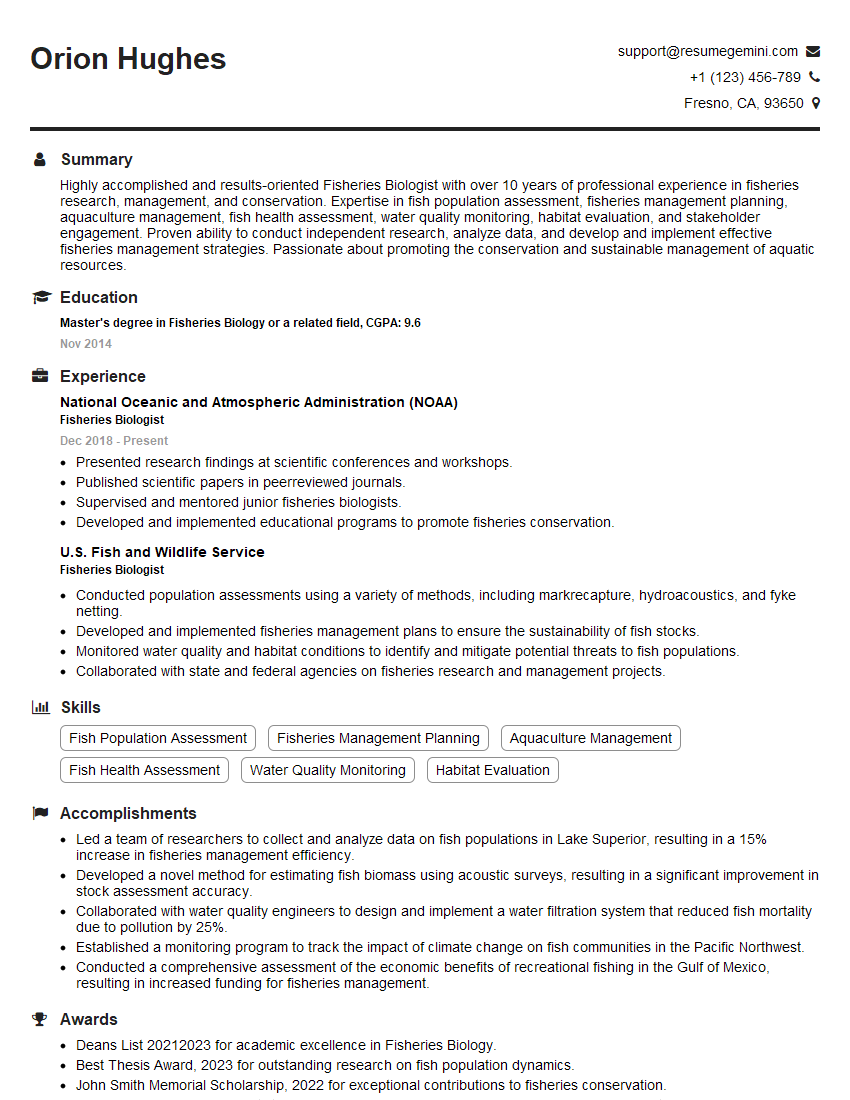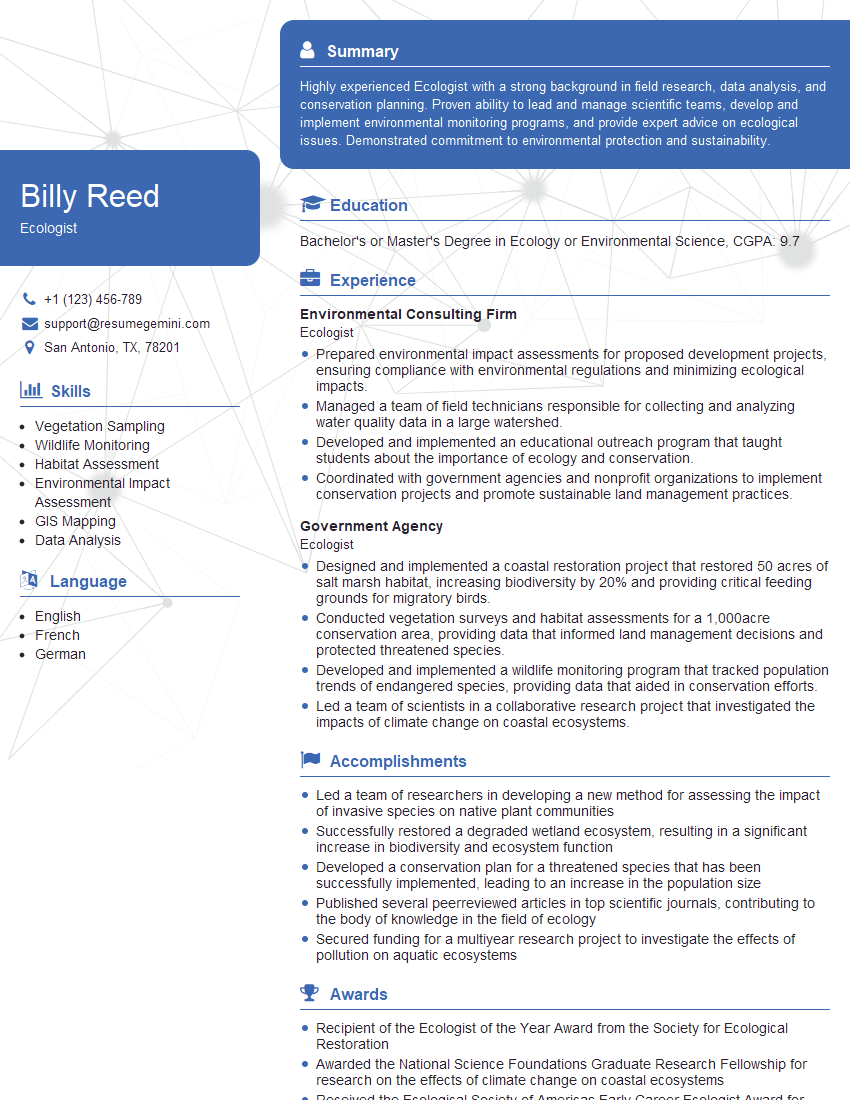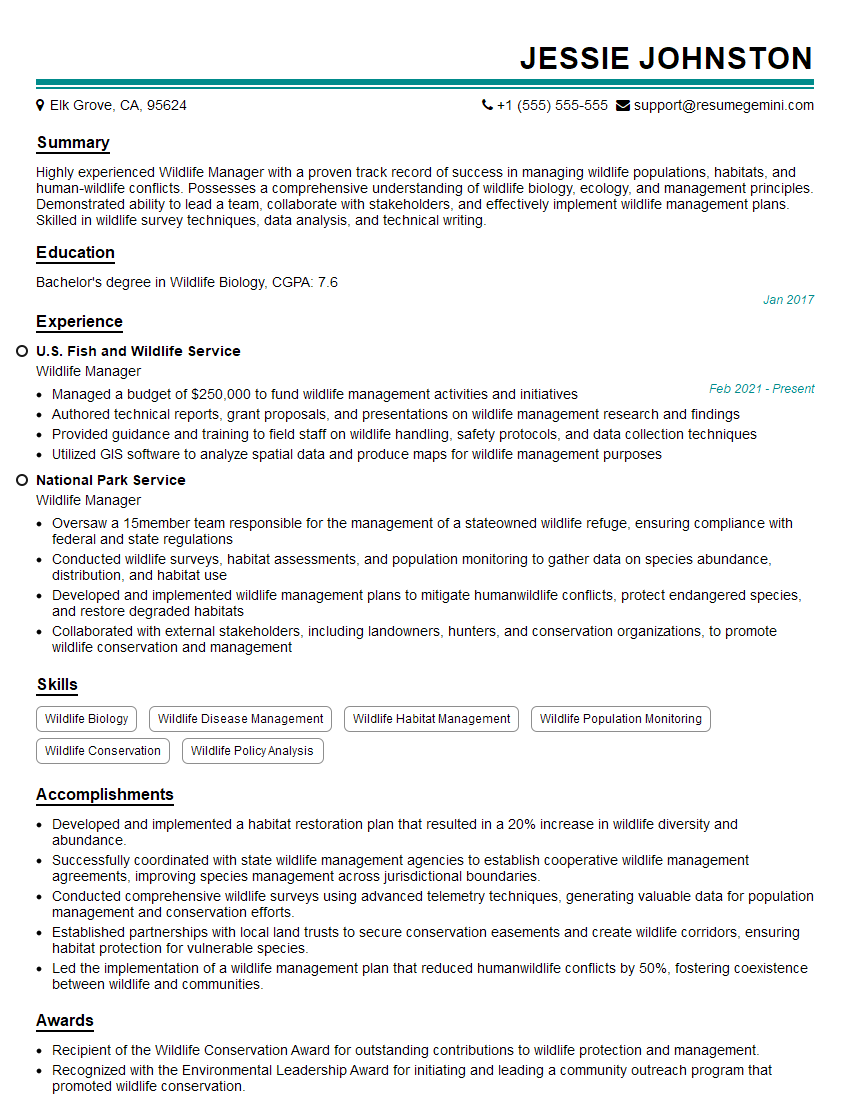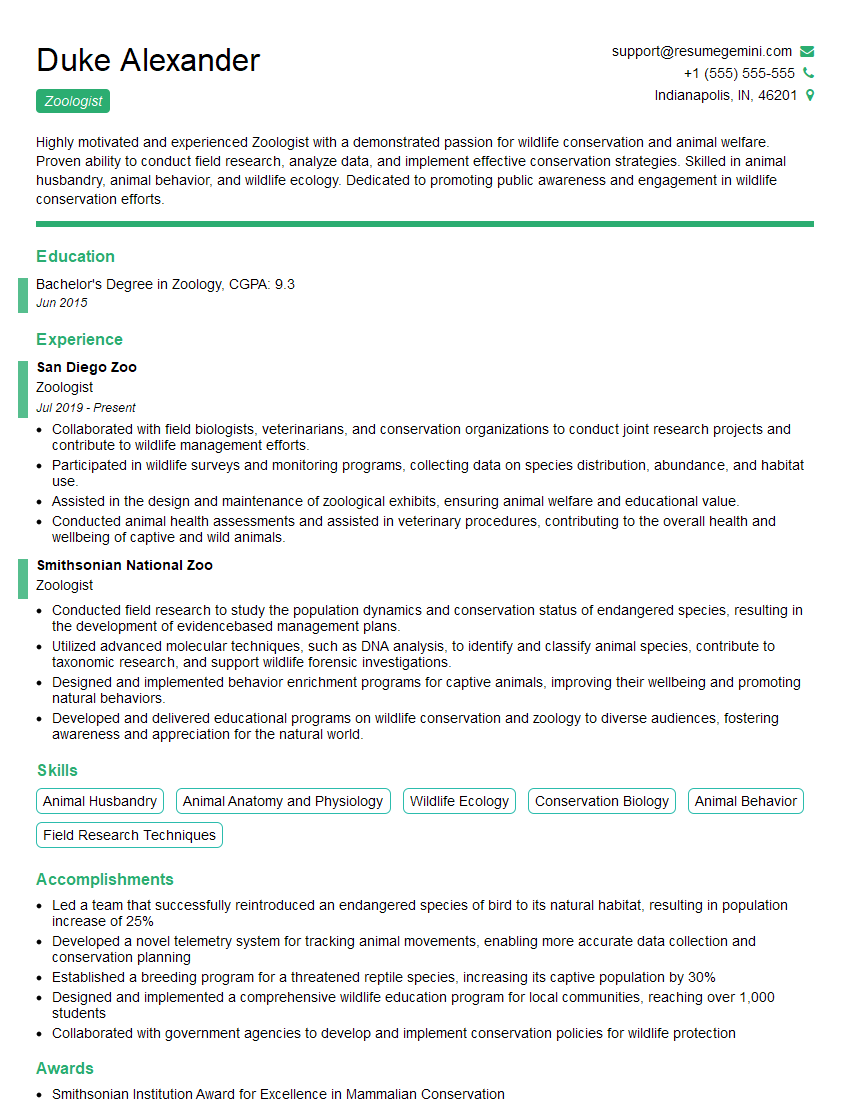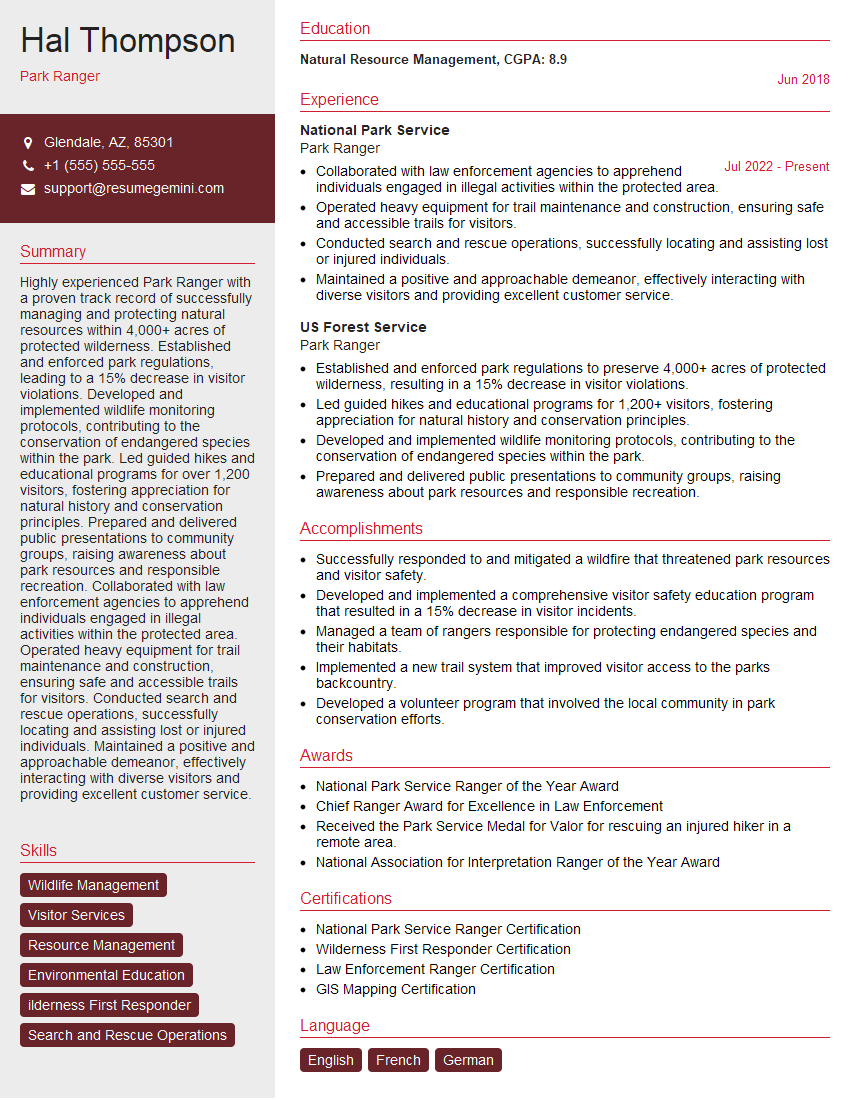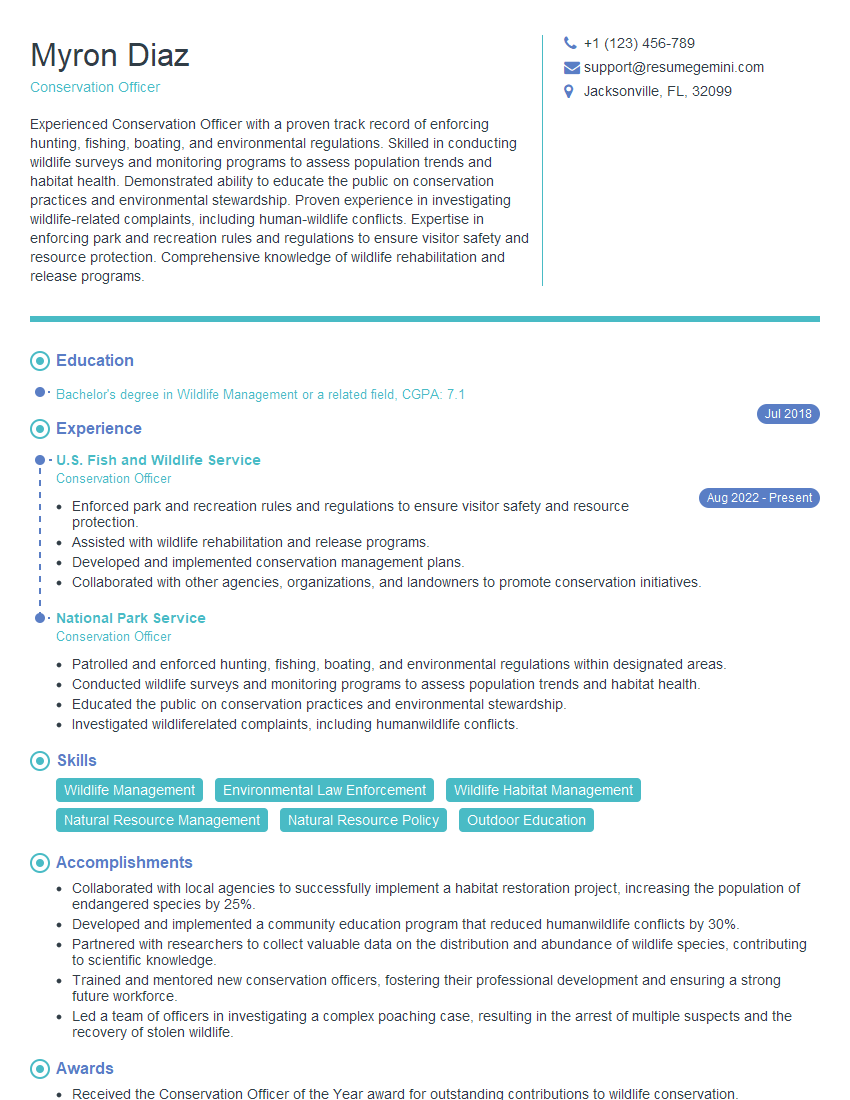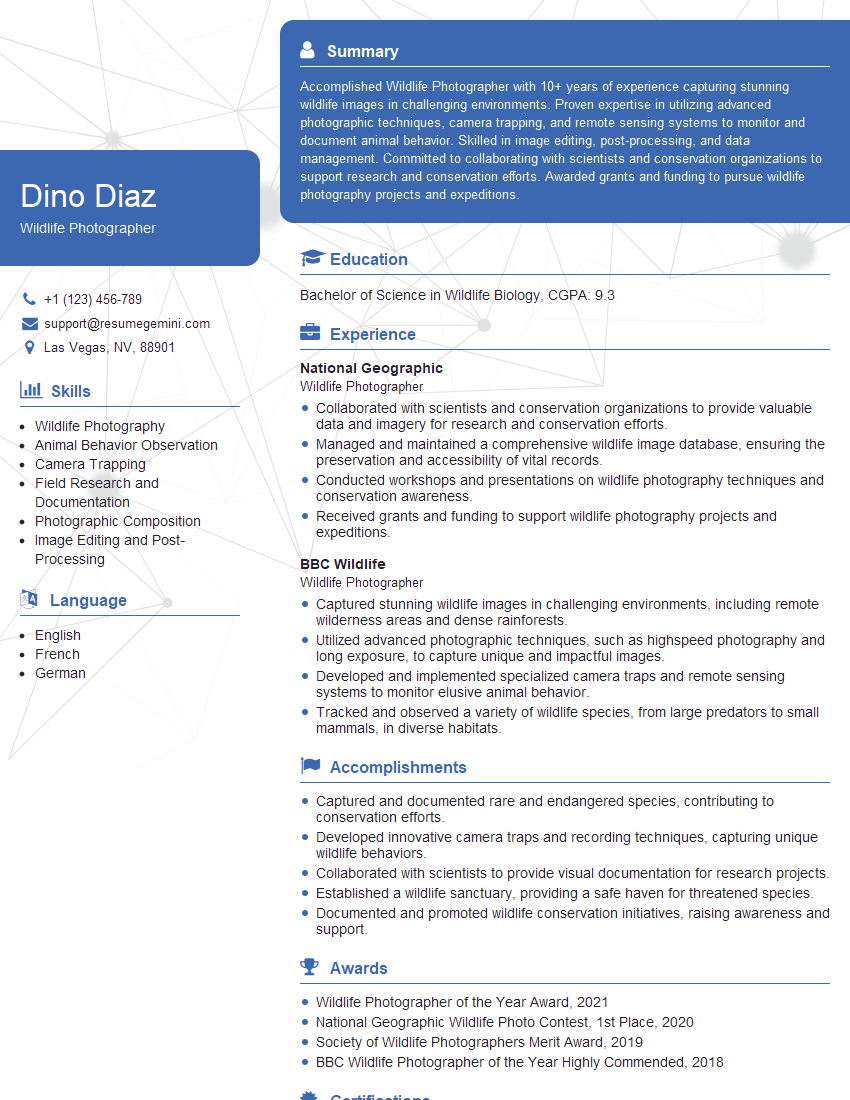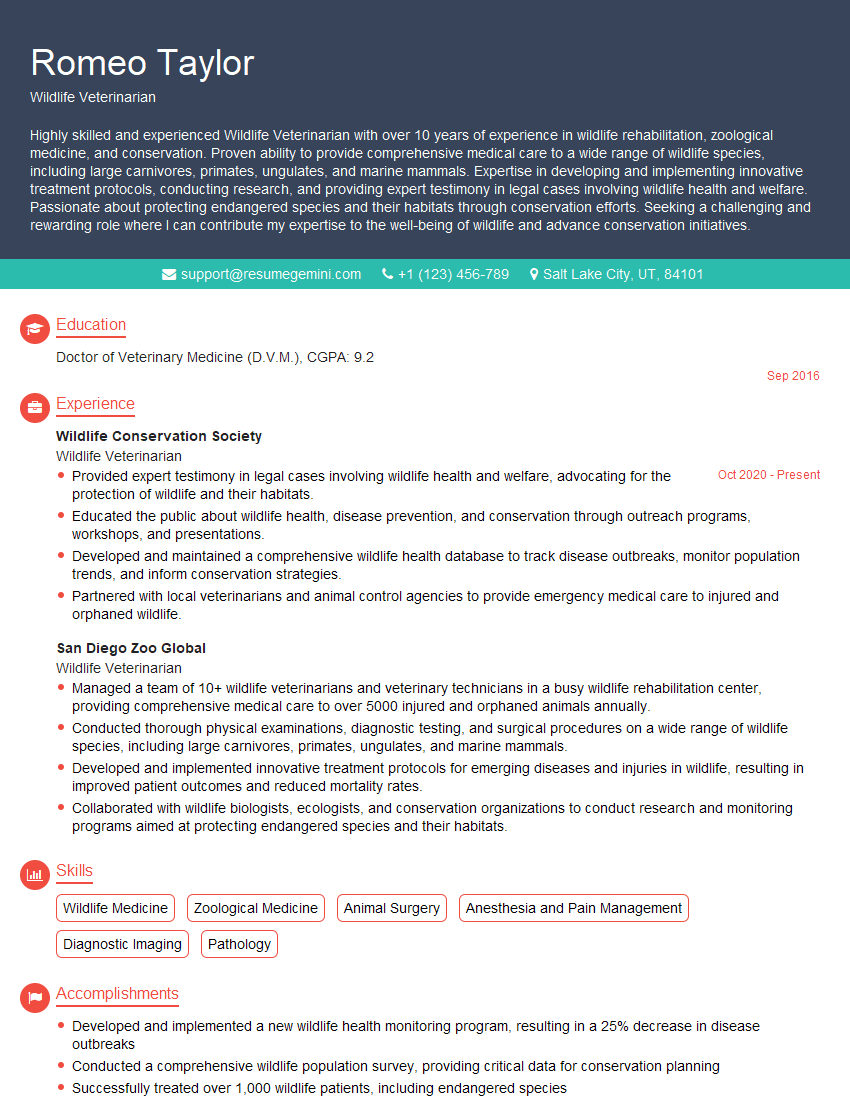Every successful interview starts with knowing what to expect. In this blog, we’ll take you through the top Wildlife Knowledge interview questions, breaking them down with expert tips to help you deliver impactful answers. Step into your next interview fully prepared and ready to succeed.
Questions Asked in Wildlife Knowledge Interview
Q 1. Explain the concept of ecological niche.
An ecological niche refers to the specific role and position a species occupies within its environment. It’s not just about where an organism lives (its habitat), but also how it interacts with other organisms and its physical surroundings. Think of it like a species’ ‘job’ in the ecosystem. This includes everything from its food sources and feeding habits to its interactions with predators and competitors, as well as its tolerance to temperature and other environmental factors.
For example, consider two bird species living in the same forest: one might occupy a niche as an insectivore feeding in the canopy, while another might be a ground-foraging seed-eater. Both are in the same habitat (forest), but their niches are distinct, allowing them to coexist without direct competition for all resources.
Understanding ecological niches is crucial for conservation efforts. By identifying the specific needs and interactions of a species, we can better understand the threats it faces and develop effective conservation strategies. If a species’ niche is compromised – due to habitat loss, for instance – its survival is at risk.
Q 2. Describe different wildlife population monitoring techniques.
Wildlife population monitoring employs various techniques, each with its strengths and limitations. These can be broadly categorized into direct and indirect methods.
Direct methods involve directly observing or counting animals. This can include:
- Complete counts: Counting every individual in a population (feasible only for small, easily observable populations).
- Partial counts: Counting individuals in a sample area and extrapolating to the entire population (requires careful sampling design).
- Mark-recapture studies: Capturing, marking, and releasing animals, then recapturing to estimate population size. This is a common method for mobile and elusive species.
Indirect methods infer population size from signs of animal presence rather than directly counting individuals. These include:
- Track counts: Counting animal tracks in a given area to estimate abundance (requires expertise in track identification).
- Sighting surveys: Recording the number of animals observed during surveys (affected by observer bias and animal detectability).
- Scat analysis: Analyzing animal droppings to determine species presence, diet, and even hormone levels (provides insights into animal health and behavior).
- Camera trapping: Deploying motion-activated cameras to capture images or videos of animals. This is particularly useful for shy or nocturnal species.
- Acoustic monitoring: Recording and analyzing animal vocalizations to estimate population size and distribution.
The choice of method depends on the species being studied, the study objectives, available resources, and the characteristics of the habitat.
Q 3. What are the key threats to biodiversity?
Biodiversity, the variety of life on Earth, faces numerous threats, often interconnected and cascading. Key threats include:
- Habitat loss and fragmentation: The destruction and division of natural habitats due to agriculture, urbanization, and infrastructure development is arguably the biggest threat. This reduces available resources and isolates populations, making them more vulnerable.
- Climate change: Shifting temperatures, altered precipitation patterns, and increased frequency of extreme weather events disrupt ecosystems and affect species distributions and survival.
- Pollution: Air, water, and soil pollution contaminate habitats, impacting animal health and reproduction. Plastics and chemical pollutants are particularly damaging.
- Overexploitation: Unsustainable harvesting of wildlife through hunting, fishing, and poaching depletes populations and can drive species to extinction.
- Invasive species: Non-native species can outcompete native species for resources, introduce diseases, and alter habitats, dramatically impacting biodiversity.
- Disease: Infectious diseases can decimate wildlife populations, particularly when combined with other stressors such as habitat loss.
Addressing these threats requires a multi-faceted approach involving habitat conservation, sustainable resource management, pollution control, and combating climate change.
Q 4. Discuss the impact of climate change on wildlife populations.
Climate change significantly impacts wildlife populations through various mechanisms. Changes in temperature and precipitation patterns alter habitats, affecting the distribution and abundance of species. For example, some species may shift their ranges towards higher altitudes or latitudes to track suitable climate conditions. This can lead to competition with existing species and disrupt existing ecological interactions. Increased frequency and intensity of extreme weather events such as droughts, floods, and wildfires can cause widespread mortality and habitat destruction.
Changes in phenology (the timing of seasonal events like migration and breeding) can also disrupt ecological synchrony, for instance, if the timing of food availability doesn’t match the timing of breeding. This can lead to reproductive failure and population decline. Ocean acidification, caused by increased absorption of CO2 by the oceans, harms marine organisms with calcium carbonate shells or skeletons, like corals and shellfish.
The effects of climate change are complex and vary among species and ecosystems. Some species may be more resilient than others, but many are facing significant challenges to their survival as a result of a changing climate.
Q 5. How do you identify and classify different animal tracks?
Identifying and classifying animal tracks requires careful observation and knowledge of local fauna. Key features to consider include:
- Size and shape of the track: Overall dimensions, length and width of the print, and the shape of the toes and claws.
- Number of toes: Most mammals have four toes, but some have five, three, or two.
- Toe pad patterns: The presence and arrangement of toe pads provide valuable clues.
- Claw marks: The presence, length, and sharpness of claw marks can indicate whether the animal retracts its claws.
- Gait pattern: The pattern of tracks left by an animal’s movement – for example, a walk, trot, or gallop – reveals information about its locomotion.
- Substrate: The type of surface on which the tracks are left (e.g., mud, snow, sand) can affect their clarity and preservation.
Using field guides, track databases, and experience are crucial for accurate identification. It’s helpful to note the context – location, surrounding vegetation, and other signs of animal activity – to improve the reliability of track identification. For example, finding a large paw print in muddy soil near a stream, along with scat and bite marks on vegetation, could confidently point toward the presence of a specific predator.
Q 6. Explain the principles of wildlife habitat management.
Wildlife habitat management aims to maintain or improve the quality of habitats for wildlife populations. Key principles include:
- Understanding habitat requirements: Identifying the specific needs of the target species, including food, water, cover, and space requirements.
- Habitat restoration: Rehabilitating degraded habitats through activities like planting native vegetation, removing invasive species, and restoring hydrological processes.
- Habitat creation: Establishing new habitats in areas where they are lacking, such as creating wetlands or planting trees.
- Habitat connectivity: Maintaining or restoring connections between habitat patches to allow for movement and dispersal of wildlife.
- Sustainable resource management: Balancing human use of resources with the needs of wildlife, for example, through sustainable forestry practices or responsible grazing.
- Monitoring and adaptive management: Regularly monitoring habitat conditions and wildlife populations to assess the effectiveness of management actions and make adjustments as needed.
Effective habitat management requires collaboration between scientists, land managers, and stakeholders to ensure the long-term conservation of wildlife and their habitats.
Q 7. Describe different methods for controlling invasive species.
Controlling invasive species requires a multifaceted approach, depending on the species and the context. Methods include:
- Physical removal: Manually removing invasive plants or animals, such as pulling weeds or trapping animals. This is effective for small-scale infestations but can be labor-intensive for larger ones.
- Chemical control: Using herbicides or pesticides to kill invasive species. This needs careful consideration to avoid harm to non-target organisms and the environment; targeted application is crucial.
- Biological control: Introducing natural enemies, such as predators, parasites, or pathogens, to control invasive species. This requires careful research to ensure that the introduced biological control agent doesn’t become invasive itself.
- Integrated pest management (IPM): A holistic approach combining multiple methods to control invasive species, aiming for long-term sustainability and minimizing environmental impacts.
- Prevention: The most effective approach is to prevent the introduction and establishment of invasive species in the first place through strict biosecurity measures, border inspections, and public awareness campaigns.
The choice of control method often involves trade-offs, and the most appropriate strategy is often context-specific. For instance, a highly invasive plant may benefit from herbicide use in combination with physical removal and restoration of native vegetation.
Q 8. What are the ethical considerations in wildlife research?
Ethical considerations in wildlife research are paramount, ensuring the well-being of animals and the integrity of scientific findings. We must prioritize the minimization of harm to animals, both physically and psychologically. This includes careful consideration of research design, ensuring methods are humane and cause minimal stress or disturbance.
Transparency and accountability are also crucial. Research protocols should be clearly defined, reviewed by ethical committees, and the results should be shared openly with the scientific community and relevant stakeholders.
Permitting and regulations must be strictly adhered to, respecting local laws and international guidelines. For example, when studying endangered species, special permits are often required, and research must be designed to avoid further endangering the population.
Finally, the potential impact on animal behavior and social structures must be carefully considered. Research can unintentionally alter animal behavior or disrupt established social patterns. Researchers must be mindful of these potential impacts and design their studies to mitigate them.
For instance, a study on primate communication might require careful observation techniques to avoid causing undue stress or altering their natural communication patterns. The researcher’s skill in this area is crucial for collecting accurate and ethical data.
Q 9. How do you assess the health of a wildlife population?
Assessing the health of a wildlife population involves a multi-faceted approach, encompassing various indicators to paint a comprehensive picture.
- Population size and density: We use techniques like mark-recapture studies or camera trapping to estimate population size and determine density across a geographical area. A decline in population size or density may indicate an underlying health problem.
- Mortality rates and causes: Monitoring mortality rates helps us identify potential threats such as disease outbreaks, poaching, or habitat loss. Necropsies (animal autopsies) on deceased animals can pinpoint the cause of death.
- Body condition: Measuring body weight, body mass index (BMI), and other physical characteristics helps determine the nutritional status of animals. Malnutrition is a strong indicator of underlying health problems.
- Disease prevalence: We can use non-invasive methods like fecal or blood samples to assess disease prevalence within a population. This information is critical for understanding disease dynamics and taking appropriate conservation measures.
- Genetic diversity: Low genetic diversity can make a population more vulnerable to disease and environmental changes. Genetic analysis helps assess the overall resilience of a population.
Combining these indicators provides a more holistic understanding of a wildlife population’s health and allows us to identify potential threats and implement effective conservation strategies. For example, a decline in body condition in a particular species might indicate habitat degradation, requiring focused action on habitat restoration.
Q 10. Explain the role of GIS in wildlife conservation.
Geographic Information Systems (GIS) are indispensable tools in wildlife conservation, allowing us to visualize, analyze, and manage spatial data related to wildlife populations and their habitats.
- Habitat mapping and analysis: GIS enables precise mapping of habitats, including identifying critical areas for breeding, foraging, and migration. This helps prioritize conservation efforts to protect vital habitats.
- Species distribution modeling: Using GIS, we can predict the potential distribution of species based on environmental variables like climate, vegetation, and topography. This is valuable for identifying potential areas for species introduction or reintroduction programs.
- Monitoring wildlife movement: GPS tracking data can be overlaid on GIS maps to track animal movements, providing insights into habitat use, migration patterns, and potential conflict areas with human activities.
- Spatial analysis of threats: GIS helps analyze the spatial distribution of threats like deforestation, poaching, or human settlements, helping to identify high-risk areas requiring focused intervention.
- Conservation planning and prioritization: GIS integrates various data layers to create comprehensive conservation plans, guiding decision-making on reserve design, habitat restoration, and conflict mitigation.
For example, a GIS analysis might reveal that a particular habitat corridor is crucial for the migration of a specific endangered species, allowing for the prioritization of its protection.
Q 11. Describe different wildlife capture and handling techniques.
Wildlife capture and handling techniques vary greatly depending on the species, its behavior, and the research objectives. Safety for both the animals and researchers is paramount.
- Trapping: Various traps are used, including snares, nets, and live traps. The choice depends on the target species and the research question. Live traps minimize stress and allow for safe handling.
- Darting: Immobilizing animals with darts containing anesthetic drugs is a common method, particularly for larger mammals. This requires trained personnel and careful monitoring of the animal’s condition.
- Netting: Mist nets are commonly used to capture birds, while larger nets can be used for bats or other small mammals. The type of net and its deployment depend on the target species.
- Restraint techniques: Once captured, animals may require various restraint techniques to ensure safe handling and prevent injury. This might include specialized equipment or trained personnel familiar with safe restraint protocols for particular species.
Each technique requires careful planning, appropriate permits, and adherence to strict safety protocols. For example, darting a large predator such as a bear requires specialized equipment and a trained team to minimize risk. A poorly executed capture can cause injury or stress, compromising both the animal’s welfare and the integrity of the research.
Q 12. What are the legal frameworks governing wildlife protection in your region?
(Note: Legal frameworks vary significantly by region. This answer provides a general overview and should not be considered legal advice.)
Wildlife protection is governed by a complex web of national and international laws and regulations. In most regions, specific legislation addresses hunting, trade, and habitat protection. Many countries have designated protected areas – national parks, wildlife reserves – where wildlife activities are restricted.
International conventions, such as the Convention on International Trade in Endangered Species (CITES), play a vital role in protecting endangered species by regulating their international trade. Enforcement mechanisms vary, but often involve fines, imprisonment, or the confiscation of illegally obtained wildlife or products.
Citizen science and community-based conservation initiatives also contribute significantly. Local communities are often at the forefront of wildlife conservation, and engaging with these communities is crucial for effective implementation.
Specific laws may include endangered species acts, wildlife conservation acts, and regulations on hunting and fishing permits. There are also regulations that address human-wildlife conflict, with mechanisms for managing situations where wildlife poses a risk to human safety or livelihoods.
Q 13. How do you design and implement a wildlife monitoring program?
Designing and implementing a wildlife monitoring program is a systematic process that involves several key steps:
- Define objectives and questions: Clearly articulate the goals of the monitoring program. What information do you need to collect? What questions are you trying to answer? Example: Assess the population trend of a specific species over a 10-year period.
- Select appropriate methods: Choose the most effective methods for collecting data based on the objectives and the species being studied. This might involve camera trapping, mark-recapture, GPS tracking, or a combination of methods.
- Establish sampling design: Determine how and where you will collect data. This requires careful consideration of spatial and temporal factors to ensure the data is representative of the population.
- Data collection and management: Implement a robust data collection protocol that is standardized and consistent. Develop a system for data storage, management, and quality control.
- Data analysis and interpretation: Analyze collected data using appropriate statistical methods. Interpret the results in the context of the research objectives and identify any trends or changes in the wildlife population.
- Reporting and communication: Communicate the findings to stakeholders, including scientists, conservation managers, and the public. Share data and reports in an accessible format.
The success of a monitoring program relies on careful planning, rigorous data collection, and effective communication. Consistent long-term monitoring is essential for detecting changes in wildlife populations and adapting conservation strategies.
Q 14. Discuss the challenges of wildlife translocation.
Wildlife translocation, the movement of animals from one location to another, presents numerous challenges:
- Habitat suitability: The release site must have suitable habitat for the translocated animals, including adequate food, water, and shelter. Thorough assessment of the new habitat is essential.
- Disease transmission: Introducing animals to a new area could introduce diseases to the existing wildlife population or expose translocated animals to new pathogens. Health screening and quarantine are crucial steps.
- Genetic compatibility: Animals should be genetically compatible with the resident population at the release site to avoid negative impacts on genetic diversity.
- Behavioral adaptation: Animals need to adapt to the new environment, including finding food, water, and shelter. Post-release monitoring is vital to assess adaptation success and address potential issues.
- Mortality rates: Translocation can be stressful, and animals may experience high mortality rates during and after the process. Careful planning and post-release monitoring are necessary to minimize mortality.
- Social dynamics: The introduction of new animals to an established group can lead to conflict, competition, or social disruption. Understanding the social structure of both the source and the receiving population is crucial.
Successful translocation requires careful planning, rigorous risk assessment, and ongoing monitoring. For example, the reintroduction of wolves to Yellowstone National Park was a complex undertaking requiring extensive research, planning, and post-release monitoring to ensure the long-term success of the project.
Q 15. Explain the importance of wildlife corridors.
Wildlife corridors are crucial strips of habitat that connect otherwise isolated patches of land, allowing animals to move freely between them. Think of them as highways for wildlife. They’re incredibly important because they help animals find mates, access food and water resources, and escape from threats like fire or disease outbreaks. Without corridors, populations can become fragmented, leading to inbreeding, reduced genetic diversity, and ultimately, higher extinction risk.
For example, imagine a forest divided by a highway. Animals like deer or bears might be unable to cross safely, leading to isolated populations on either side. A wildlife corridor, such as an overpass or an underpass, could allow them to safely traverse the barrier, maintaining genetic flow and population health.
The design and management of corridors are critical. They must be appropriately sized for the target species and must contain adequate resources like food and cover to support their movement. Consideration must be given to the potential for human-wildlife conflict along the corridors, necessitating effective mitigation strategies.
Career Expert Tips:
- Ace those interviews! Prepare effectively by reviewing the Top 50 Most Common Interview Questions on ResumeGemini.
- Navigate your job search with confidence! Explore a wide range of Career Tips on ResumeGemini. Learn about common challenges and recommendations to overcome them.
- Craft the perfect resume! Master the Art of Resume Writing with ResumeGemini’s guide. Showcase your unique qualifications and achievements effectively.
- Don’t miss out on holiday savings! Build your dream resume with ResumeGemini’s ATS optimized templates.
Q 16. What are the signs of wildlife disease?
Signs of wildlife disease can vary greatly depending on the species and the specific disease, but some general indicators include lethargy, weight loss, unusual behavior (e.g., aggression, disorientation), abnormal discharge from eyes or nose, difficulty breathing, lameness, skin lesions, and unusual vocalizations. A significant decline in a population’s numbers can also be a clue. Often, it’s difficult to pinpoint a specific disease without expert veterinary examination.
For instance, a noticeable limp in a deer could indicate a foot infection or a neurological disorder. Mass mortality events, where many animals die suddenly in a localized area, often signal a significant disease outbreak. Surveillance programs, including regular health checks on captured animals and monitoring of carcass numbers, are essential for early detection.
It’s crucial to report any suspected disease in wildlife to relevant authorities immediately. This enables rapid response, helping to prevent widespread outbreaks and protect both animal and human health. Proper biosecurity measures are also essential to minimize disease transmission amongst wildlife populations and to people.
Q 17. Describe different methods for estimating wildlife population size.
Estimating wildlife population size is challenging, but various methods exist. The choice of method depends on the species, habitat type, and available resources. Common methods include:
- Complete Counts: Suitable only for small, easily observable populations, such as nesting birds in a limited area. This involves directly counting every individual.
- Mark-Recapture: A more widely applicable technique. Animals are captured, marked (e.g., with tags or paint), released, and then recaptured after a period. By comparing the proportion of marked animals in the second capture to the total number captured, the population size can be estimated. This is often done using statistical models.
- Distance Sampling: Observers survey a line transect and record the distance to each animal sighted. Statistical models are then used to estimate population density, which can be extrapolated to the entire area.
- Index Methods: These methods don’t directly estimate population size but measure indicators related to population abundance, such as scat counts, tracks, or vocalizations. These indices can be useful for comparing population trends over time or across different locations.
Each method has its own strengths and limitations, and often, a combination of methods is used to obtain a more reliable estimate. Careful study design and statistical analysis are crucial to minimize bias and error.
Q 18. How do you assess the impact of human activities on wildlife?
Assessing the impact of human activities on wildlife involves a multifaceted approach, combining data collection, analysis, and interpretation. It’s often a complex process, requiring the synthesis of multiple data sources.
We can assess impact through various methods. Habitat loss and fragmentation can be quantified using remote sensing and GIS analysis. Changes in wildlife distribution and abundance can be tracked through population surveys and monitoring programs. Bioindicators, such as water quality or plant diversity, can reveal indirect impacts. Physiological studies might reveal stress levels in animals exposed to human activities. Finally, community-based surveys can provide valuable insights into changes in local wildlife populations observed by people living near these areas.
For example, the construction of a dam might lead to habitat loss, fragmentation, and alterations in water flow, affecting fish populations and other riparian species. Analyzing data from before and after the dam’s construction allows assessment of the project’s impact, allowing for mitigation strategies to be developed and implemented during the construction phase of future projects.
Q 19. Discuss the role of community involvement in wildlife conservation.
Community involvement is absolutely vital for successful wildlife conservation. Local communities often possess invaluable traditional ecological knowledge (TEK) and are directly impacted by wildlife management decisions. Engaging them ensures conservation efforts are relevant, effective, and sustainable.
Effective community engagement involves several steps. First, communities need to be involved in planning and decision-making processes. Second, conservation programs should address local needs and priorities, perhaps by creating jobs related to ecotourism or sustainable harvesting. Third, education and awareness campaigns should be implemented to foster understanding and support for wildlife conservation. Finally, co-management schemes, where communities and government agencies share responsibility for managing wildlife, can be extremely successful. For example, community-based anti-poaching patrols can significantly reduce illegal hunting.
Community engagement also helps reduce conflict between humans and wildlife. By understanding local concerns and working collaboratively, we can develop strategies to minimize negative impacts, such as crop raiding by elephants or livestock predation by wolves, fostering positive human-wildlife coexistence.
Q 20. What are the different types of wildlife surveys?
Wildlife surveys employ various methods, depending on the species and objectives. These surveys aim to collect data on wildlife distribution, abundance, habitat use, and other ecological parameters. Some common types include:
- Point counts: Observers record the number of animals seen or heard from a series of predetermined points.
- Line transects: Observers walk along a designated line and record the distance and direction to each animal sighted.
- Quadrat sampling: Researchers sample animals within square plots of a specific size, useful for sessile or slow-moving organisms.
- Camera trapping: Motion-activated cameras capture images of animals passing by, which is ideal for elusive species.
- Acoustic monitoring: Using sound recorders to detect animal vocalizations and estimate their abundance or distribution.
- Genetic surveys: Using non-invasive samples (e.g., scat, hair) to identify species present, estimate population sizes, and study genetic diversity.
The choice of survey method depends on the species, habitat, and research questions. A well-designed survey incorporates statistical rigor to ensure the collected data is representative and reliable.
Q 21. Explain the concept of carrying capacity in wildlife management.
Carrying capacity refers to the maximum population size of a given species that an environment can support sustainably, considering the available resources like food, water, shelter, and space, as well as factors such as predation and disease. It’s not a fixed number but rather a dynamic concept that varies with environmental changes. In wildlife management, understanding carrying capacity is essential for setting sustainable harvest levels and preventing overgrazing or other forms of habitat degradation.
If a population exceeds its carrying capacity, it might experience a population crash due to resource depletion, increased competition, disease, or starvation. Conversely, if a population is far below its carrying capacity, it might indicate habitat degradation or other limiting factors. Monitoring populations and assessing carrying capacity is a continuous process, integrating ecological data and modelling techniques. Adaptive management approaches are key to adjust strategies based on monitoring data.
For example, a certain area of grassland can support only a limited number of deer before overgrazing leads to habitat degradation and the decline of the deer population itself. Wildlife managers use this knowledge to set hunting quotas that keep deer numbers within the carrying capacity of the habitat.
Q 22. Describe different types of wildlife conflict mitigation strategies.
Wildlife conflict mitigation strategies aim to reduce negative interactions between humans and wildlife. These strategies are multifaceted and tailored to the specific conflict. They often involve a combination of approaches:
- Habitat Modification: This includes altering the environment to reduce encounters. For example, building fences to keep elephants out of crop fields, or creating wildlife corridors to guide animals away from human settlements.
- Livestock Protection: Protecting livestock from predators is crucial. This can involve using guard dogs, electric fencing, or improved husbandry practices (e.g., night corrals).
- Compensation Schemes: Providing financial compensation to people who have suffered losses due to wildlife can encourage tolerance and reduce retaliatory actions against animals.
- Community Engagement: Educating and involving local communities is vital. This includes raising awareness about wildlife behavior, the importance of conservation, and the effectiveness of mitigation strategies. Participatory approaches ensure community ownership and success.
- Translocation: Relocating problem animals to less populated areas, a last resort, should be implemented carefully to avoid further conflicts.
- Addressing Underlying Issues: Sometimes conflicts are rooted in land-use issues, lack of resources, or poverty. Addressing these underlying issues can be crucial for long-term conflict resolution.
For instance, in areas with human-elephant conflict, a combination of electric fencing, crop raiding deterrent techniques, and community education programs is often employed for effective conflict mitigation.
Q 23. How do you analyze wildlife data using statistical methods?
Analyzing wildlife data using statistical methods is essential for understanding population dynamics, habitat use, and the impact of conservation efforts. Common methods include:
- Capture-Mark-Recapture (CMR): Used to estimate population size. We capture, mark, and release animals, then recapture them later to estimate population size using specific formulas.
N = (M*C)/R(where N is population size, M is marked animals, C is total captured in second sample, R is recaptured marked animals) - Distance Sampling: Used to estimate abundance by surveying animals from a line transect and modeling the probability of detection based on distance.
- Spatial Analysis: GIS (Geographic Information Systems) and spatial statistics (e.g., kernel density estimation) help map wildlife distributions and habitat use, identifying important areas for conservation.
- Survival Analysis: This helps understand animal mortality rates, identifying factors influencing survival. For example, we can model survival based on age, sex, or environmental variables.
- Regression Analysis: Used to examine the relationships between variables, such as the effect of habitat fragmentation on population density.
Software like R and specialized ecological software packages are frequently used for analyzing such data. Proper statistical techniques are crucial for drawing accurate conclusions and informing conservation actions. For example, statistical modeling can help predict future population trends under different management scenarios.
Q 24. Explain the role of genetics in wildlife conservation.
Genetics plays a crucial role in wildlife conservation through:
- Population Genetics: Analyzing genetic diversity helps us assess population health, identify inbreeding, and track gene flow among populations. Low genetic diversity increases vulnerability to disease and environmental changes.
- Species Identification and Taxonomy: Genetic techniques can help identify cryptic species (species that look alike but are genetically distinct) and resolve taxonomic uncertainties, guiding conservation efforts more effectively.
- Conservation Breeding Programs: Genetic management in captive breeding programs is essential to maintain genetic diversity and prevent inbreeding depression, improving the success of reintroduction programs.
- Forensics: DNA analysis can be used to identify poached animals, trace illegal wildlife trade, and prosecute offenders, contributing to anti-poaching efforts.
- Disease Management: Genetic markers can help identify disease susceptibility and resistance within populations, informing disease management strategies.
For example, genetic analysis can reveal the level of genetic diversity within a fragmented population of tigers, informing decisions on translocation to enhance genetic health and long-term survival.
Q 25. What are the benefits of wildlife tourism?
Wildlife tourism, when managed responsibly, offers several significant benefits:
- Economic Benefits: It generates revenue for local communities through employment opportunities (guides, lodge staff, etc.) and business development (accommodation, restaurants).
- Conservation Funding: Tourism revenue can directly fund conservation efforts, including habitat protection, anti-poaching initiatives, and research.
- Increased Awareness: Exposure to wildlife can foster appreciation for nature and conservation, increasing public support for conservation programs.
- Community Empowerment: Well-managed tourism can empower local communities to take ownership of conservation efforts, promoting sustainable resource management.
- Improved Infrastructure: Tourism development can lead to improvements in infrastructure (roads, communication networks) benefiting both locals and wildlife conservation.
However, it is crucial to implement sustainable tourism practices to minimize negative impacts on wildlife, such as habitat disturbance, stress, and human-wildlife conflict.
Q 26. How do you communicate complex scientific information to a non-scientific audience?
Communicating complex scientific information to a non-scientific audience requires careful consideration of the audience’s knowledge and understanding. Effective communication strategies include:
- Using Simple Language: Avoid jargon and technical terms; use plain language and analogies. Explain complex concepts in simple terms.
- Visual Aids: Employ graphs, charts, images, and videos to illustrate key points, making information easier to understand and remember.
- Storytelling: Use narratives and real-life examples to make the information relatable and engaging. People connect more with stories than abstract data.
- Interactive Communication: Encourage questions and discussions, creating a two-way flow of information and clarifying any misunderstandings. Use methods like Q&A sessions or workshops.
- Tailoring the Message: Adapt the message to the specific audience’s interests and concerns. What resonates with a group of school children will differ from what interests policy makers.
For example, instead of saying “We observed a significant decline in genetic diversity,” you could say, “The animals are becoming less healthy because their genes are becoming too similar, making them more vulnerable to disease.”
Q 27. Describe your experience with wildlife rehabilitation.
My experience in wildlife rehabilitation includes working at [Name of Organization/Location]. We focused on rescuing and treating injured or orphaned wildlife. My roles included:
- Assessing Animal Condition: Evaluating the animal’s physical health, injuries, and nutritional status upon arrival.
- Providing Medical Care: Administering medications, providing wound care, and managing any necessary surgery in collaboration with veterinary professionals.
- Nutritional Management: Ensuring proper nutrition through appropriate feeding regimes, tailored to the species and individual needs.
- Behavioral Enrichment: Providing stimulating environments to encourage natural behaviors and reduce stress.
- Rehabilitation and Release: Gradually acclimating the animal to its natural environment before eventual release, often involving monitoring post-release.
One memorable case involved a young orphaned chimpanzee. The meticulous care, including specialized formula feeding, social interaction with other young chimps (under careful supervision), and gradual reintroduction to a forested sanctuary, led to its successful release and integration into a wild troop.
Q 28. Discuss a time you had to solve a complex problem related to wildlife management.
During a project assessing the impact of a new hydroelectric dam on a river otter population, we faced a complex problem: our initial population estimates were significantly lower than expected, raising concerns about the project’s effects.
We used a multi-step approach to solve the problem:
- Re-evaluate Methodology: We critically reviewed our capture-mark-recapture methods, identifying potential biases in our sampling techniques. We found that our initial trapping locations did not fully cover the otter’s expanded habitat range.
- Expand Sampling Area: We increased the trapping area to encompass a wider range of habitats known to otters, utilizing GIS and local knowledge to guide our sampling.
- Implement New Techniques: We integrated camera trapping and scat analysis to supplement our data, providing independent estimates of otter abundance and habitat use.
- Statistical Modeling: We used more sophisticated statistical models to account for the heterogeneous distribution of otters and the potential biases in our data. This involved robust design CMR modeling.
- Integrate Other Data: We consulted other datasets, like citizen science reports and anecdotal observations to triangulate our findings.
Our revised estimates, after this rigorous reassessment, showed a much larger otter population than initially anticipated, mitigating some of our initial concerns, although it highlighted the need for continued monitoring of otter movement and habitat usage near the dam. This experience reinforced the importance of robust research design and the need for flexible adaptation when faced with unexpected results in wildlife management.
Key Topics to Learn for Your Wildlife Knowledge Interview
Acing your wildlife knowledge interview requires a well-rounded understanding of the field. Focus your preparation on these key areas:
- Wildlife Ecology and Behavior: Understand population dynamics, habitat requirements, predator-prey relationships, and the impact of environmental changes on wildlife populations. Consider practical applications like population monitoring techniques and conservation strategies.
- Wildlife Conservation and Management: Explore different conservation approaches, including habitat restoration, species reintroduction programs, and the management of human-wildlife conflict. Think about how to apply theoretical knowledge to real-world scenarios like designing a protected area or managing invasive species.
- Wildlife Legislation and Policy: Familiarize yourself with relevant national and international laws and regulations pertaining to wildlife protection and management. Consider the ethical considerations involved in wildlife conservation and management decisions.
- Research Methods in Wildlife Biology: Understand common research techniques used in studying wildlife, including data collection methods, statistical analysis, and scientific writing. Think critically about the strengths and limitations of different approaches.
- Wildlife Health and Disease: Gain knowledge of common wildlife diseases, their transmission, and the impact on populations. Consider the role of veterinary science in wildlife conservation.
- GIS and Remote Sensing Applications: Understand how geographic information systems and remote sensing are used in wildlife research and management. Consider how these technologies can be used to monitor wildlife populations, track movements, and manage habitats.
Next Steps: Unlock Your Wildlife Career
Mastering wildlife knowledge is crucial for career advancement in this exciting and impactful field. A strong resume is your key to unlocking opportunities. Make sure yours is ATS-friendly—optimized to pass through applicant tracking systems and land you interviews.
To create a resume that truly showcases your skills and experience, we recommend using ResumeGemini. It’s a trusted resource for building professional resumes, and we provide examples tailored specifically to the Wildlife Knowledge sector to help you get started. Take the next step towards your dream career today!
Explore more articles
Users Rating of Our Blogs
Share Your Experience
We value your feedback! Please rate our content and share your thoughts (optional).
What Readers Say About Our Blog
This was kind of a unique content I found around the specialized skills. Very helpful questions and good detailed answers.
Very Helpful blog, thank you Interviewgemini team.


